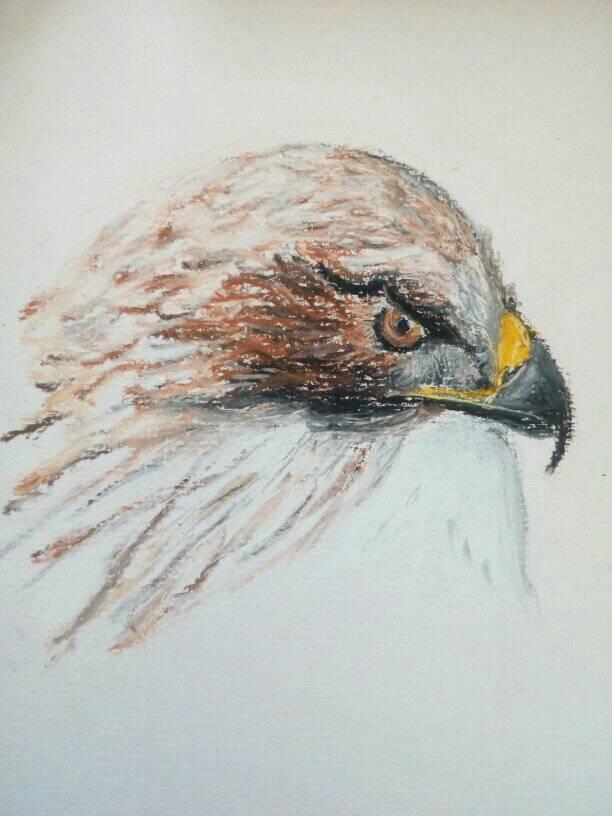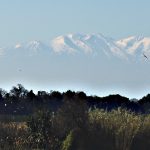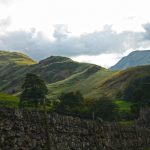View from my window in early spring: the étang de Canet in the foreground and the Canigou mountain behind. Though it looks close, it’s actually 50 kilometers (over 30 miles) away. The Canigou (meaning “dog’s tooth” in Catalan) is the last of the high peaks before the Pyrenees reach the Mediterranean Sea. It stands just shy of 3000 meters (almost 10,000 feet) and, in the right conditions, can be seen from as far away as Marseille—263 kilometers (163 miles)!
TEXT AND IMAGES BY ELEANOR MARTINDALE
Today, I saw some storks. Three, to be exact, flying over the Western Mediterranean marshlands where I live, heading to their breeding grounds farther north. Late January and a presage of spring already, accompanying the mimosa trees that have suddenly burst into flower as though a child has taken a pot of the brightest yellow paint she could find and splashed drops all over a wintery canvas. I wonder where the storks are headed. Germany, perhaps, or Holland—or maybe southern England, where they have just begun nesting again after an absence of over 600 years.
I am lucky to live on one of the main migration corridors of the Pyrenees, and my home office affords me a view across untouched wetlands to the mountains beyond. I’m often distracted as I work, looking up from my computer screen to see a kestrel hovering right in front of my window, or an eagle resting on a branch, oblivious to my regard. A marsh harrier swooping low over the lagoon seems like an old friend, so often do I see her. Our relationship is entirely one-sided, of course. The sight of her makes me smile though she feels nothing at all for me. I am neither a threat nor food. I am a thing to be ignored.

Winter sunset over the Canigou, with heron in flight.
Their disinterest is perhaps part of the charm. I can watch, unseen, and in my idle moments I stare from my window at the gulls and doves and starlings who are always present, with herons and egrets and flamingos farther afield in the brackish water of the lagoon. Sometimes, a quarrel breaks out: Gulls mob a buzzard jealously guarding his catch, or a flock of angry lapwings harry my harrier friend. And it seems that I am not alone in my appreciation of that golden-headed bird, for two males fought over her last spring, all posturing talons and flapping wings.
From my vantage point I have seen a kestrel catch a snake and a peregrine falcon blown right out of the sky by the tramontane, that fierce wind which drives across the Roussillon plain from high up in the Pyrenees. The bundle of disgruntled gray shook sand from his feathers and took to the skies with nothing hurt but his pride.
It was just as the spring migration was beginning last year that France entered its first lockdown. During this time, the busy road that separates my house from the wetlands was silent. And in that silence, nature could be heard. From high in the umbrella pines that border the road came a thousand voices—starlings and finches and orioles and warblers, opening their lungs in a chorus only they could understand.
But no birds were visible in the dense green foliage. It seemed the tree itself was singing.


Booted eagle (left) and goldfinch (right), oil pastels on A4 paper.
And beyond the singing tree, another sound usually lost in the constant roar of traffic: the distant sighing of the sea.
Lockdown ended in early summer and a different migration began: humans from the north descending in their thousands on this quiet, coastal town. The singing tree and the sighing sea fell silent once more, drowned in tires rolling on tarmac and holidaymakers intent on having fun. My partner and I made our annual migration too, heading west in search of cool mountain air, fleeing the masses on the beach. And again we found sounds of nature. In vast meadows of wildflowers were the buzz and hum and hiss of a million tiny creatures. I had forgotten that such small beings could make such a noise. It is so rare to hear it, now. To think that it used to be normal, this orchestra of insects in flowering grasses. It was the sound of everywhere.
As summer reached boiling point and the air crackled with electricity, swallows began to gather in our high valley, more and more each day until they numbered in the thousands. Soon they would begin their long journey across the Pyrenees; across the Mediterranean Sea and the Sahara Desert; across the whole of Africa. That such a small bird can travel so far will never cease to amaze me.

My Italian greyhound, Maestro, often accompanies me on walks around the marshes.
We were hopeful, in those first weeks of autumn, that perhaps the pandemic situation might improve. That perhaps we might see some normality return, whatever normality might mean. We were wrong. Instead of seeing family at Christmas, my partner and I returned to the Pyrenees and watched snow fall and vultures soar.
And now almost a year has passed. I see the storks arrive and they are a comfort. In all the upheavals we have felt, in all the distress and the pain and the not knowing, these birds are a constant. Whatever else happens, these birds still answer to the inexorable pull of migration.
Soon others will join the storks in their flight north: common buzzards, honey buzzards, kites black and red, booted eagles and Bonelli’s eagles and harriers and hobbies and kestrels. They will fill the sky above the lagoon and rest perhaps for a day, before dispersing across France and further afield. I will see ospreys and a month later my family in England will too. Whilst we are grounded, they may fly.
And then in the summer, there will again be swallows.
Eleanor Martindale is a self-employed online tutor, teaching English literature, creative writing, and French to young people all over the globe. Born and raised in the U.K., she has spent all her adult life in France and now lives in French Catalonia with her French-Catalan partner, Bernard Salles, a professional musician. She plays the violin in several musical groups that Bernard runs, and when she isn’t teaching, she is usually found working on one of their orchestral projects. In whatever spare time she can find, she enjoys photography, drawing and painting, and of course writing.







